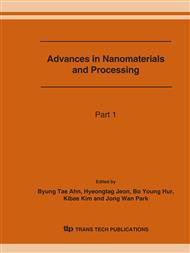p.61
p.65
p.69
p.73
p.77
p.81
p.85
p.89
p.93
ZnO Nanowalls and Nanocolumns Grown by Metalorganic Chemical Vapor Deposition
Abstract:
ZnO nanowalls and nanocolumns were synthesized on Si3N4 (50 nm)/Si (001) substrates at low growth temperature (350 and 400 oC) by metalorganic chemical vapor deposition (MOCVD) with no metal catalysts. ZnO nanowalls with extremely small wall thicknesses below 10 nm and nanocolumns with diameters over 100 nm were formed on the Si3N4/Si substrates relying on MOCVD-growth temperature. It was found that ZnO nanowalls have a strong c-axis preferred orientation with a hexagonal structure, while ZnO nanocolumns have a weak c-axis preferred orientation with broken stacking orders in synchrotron x-ray scattering experiments. In addition, strong free-exciton emission from the ZnO nanowalls was clearly observed in photoluminescence measurements. On the other hand, we could not observe any emission bands from the ZnO nanocolumn samples.
Info:
Periodical:
Pages:
77-80
Citation:
Online since:
June 2007
Authors:
Keywords:
Price:
Сopyright:
© 2007 Trans Tech Publications Ltd. All Rights Reserved
Share:
Citation:


